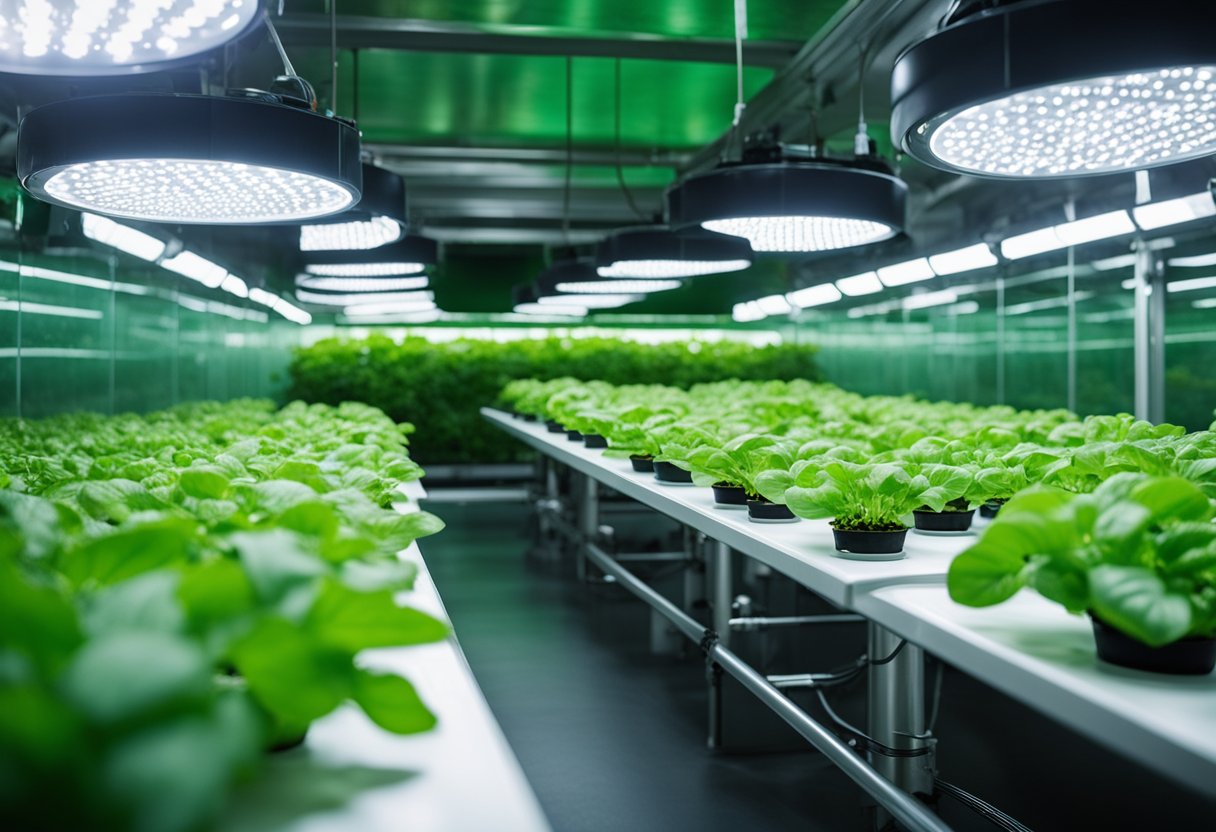
Life Support Systems for Space Colonies – As we advance into an era where space colonies become a part of our reality, the need for robust and sustainable life support systems has never been more imperative. These systems are essential for creating habitable environments where human life can thrive beyond Earth. Within the confines of a space colony, they replicate the natural life-supporting processes of our planet, such as air revitalisation, water purification, and waste recycling.
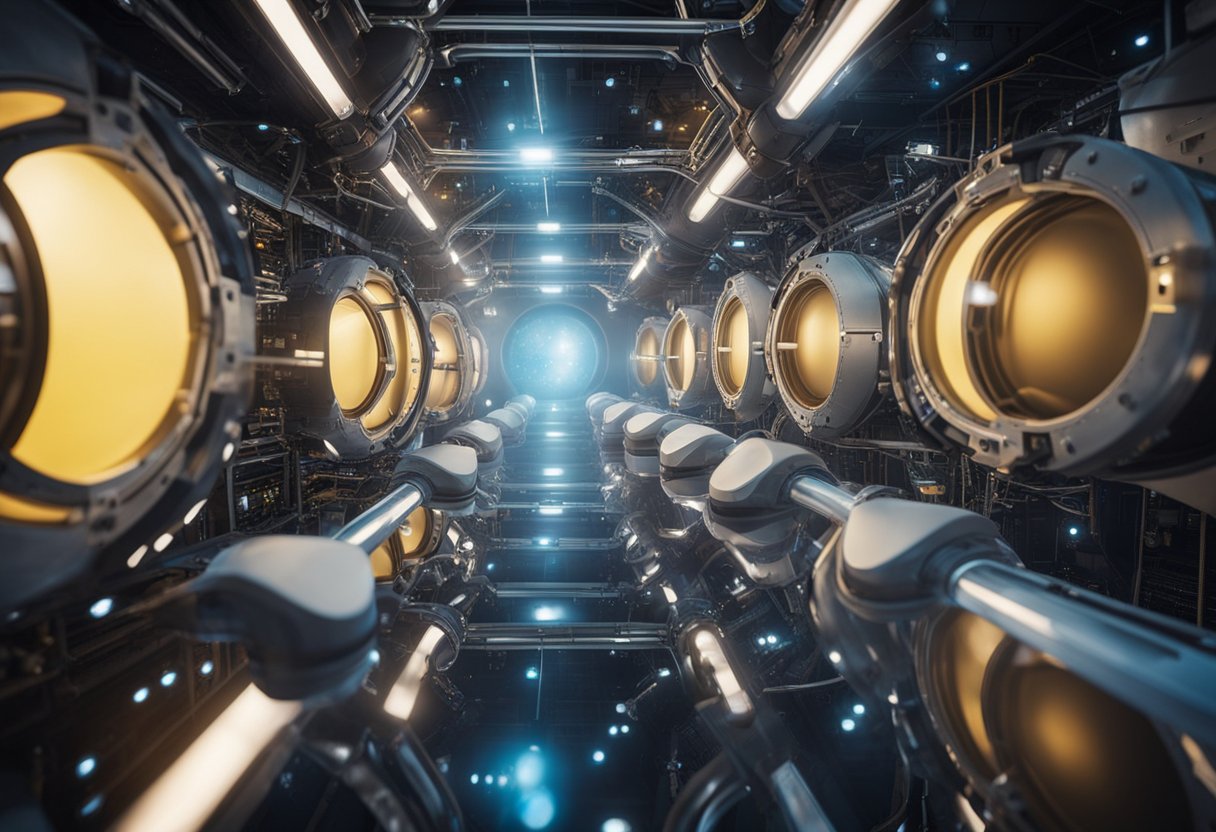
With space colonies in mind, it becomes clear that the success of these extraterrestrial habitations relies heavily on the efficiency and reliability of their life support systems. Innovations in technology and engineering have paved the way for more advanced systems that can support long-duration missions and possibly permanent settlements. Embracing bio-regenerative life support systems, for example, integrates biological processes, such as agriculture for food supply, to enhance sustainability and reduce reliance on Earth-based resources.
In tracing the progress of life support systems (LSS), we observe a remarkable journey from the rudimentary arrangements of initial missions to the sophisticated technologies that promise to sustain future space colonies.
The International Space Station (ISS) represents a significant milestone in the development of LSS. Over the years, NASA’s continued endeavours have produced an Environmental Control and Life Support System (ECLSS) that recycles water and air, permitting long-duration habitation in space. The first life support system designed to support a cosmonaut was on Yuri Gagarin’s Vostok spacecraft. This groundwork laid by pioneering missions culminated in the robust systems supporting life aboard the ISS.
Initially, closed ecological systems attempted to create self-sustaining environments by integrating biological components. However, they showed limited long-term viability for human sustenance in space. This challenge gave rise to the concept of a Controlled Ecological Life Support System (CELSS), which employs meticulously regulated interactions between humans, plants, and microorganisms to produce food, purify water, and recycle wastes.
Technological advancements have revolutionised the Environmental Control and Life Support System (ECLSS) technology. We’ve seen an evolution from the systems that supported early space exploration towards more efficient and reliable mechanisms. These systems enhance astronauts’ well-being and mark a critical step forward in our commitment to establishing a sustainable human presence in space. The continuous refinement of ECLSS technology not only bolsters space travel but also contributes to improvements on Earth, as certain advancements trickle down into terrestrial applications.
As we establish colonies beyond Earth, our life support systems must meticulously manage vital resources such as oxygen and water and ensure sustainable food production and waste management.
To maintain a breathable atmosphere within space habitats, the Environmental Control and Life Support System (ECLSS) is crucial. It encompasses the Oxygen Generation System, which electrolyses water to produce oxygen, and the Air Revitalisation System to remove carbon dioxide and balance humidity. Efficient air revitalisation is vital for ensuring astronaut health and conserving valuable resources.
Our survival hinges on a reliable supply of water, necessitating advanced Water Recovery and Purification Systems. We employ techniques like distillation and filtration to reclaim and purify water from various sources, including wastewater. Significant strides have been made with the Water Recovery System (WRS), which mirrors processes used in terrestrial water treatment plants.
We’re pioneering sustainable methods for food production in zero-gravity conditions through the integration of photobioreactors for growing algae and hydroponic systems for cultivating crops. Circular systems that recycle waste materials are essential, converting organic waste back into nutrients. This closed-loop approach not only provides us with continuous food production but also integrates waste management practices, thus reducing our reliance on Earth-supplied resources.
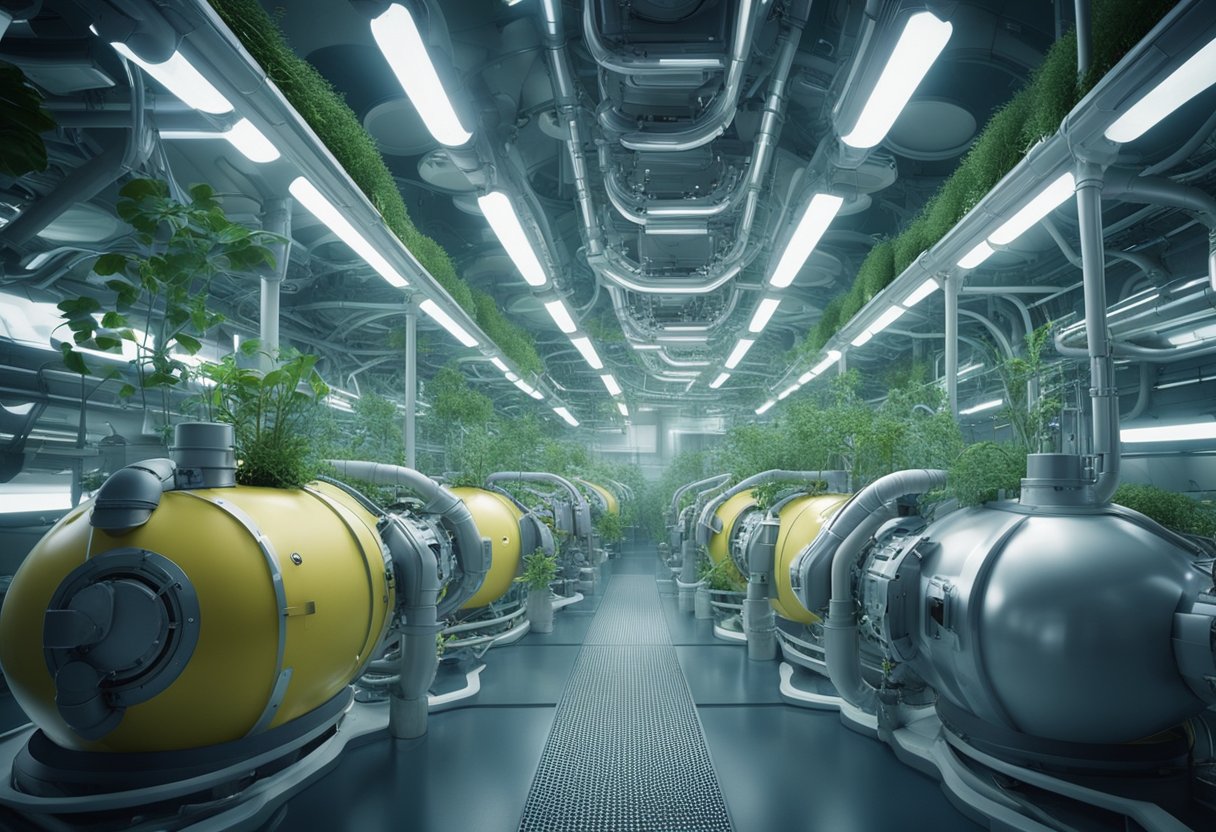
Bioregenerative Life Support Systems (BLSS) are imperative for sustainable long-term space habitation, providing vital resources through the recycling of air, water, and waste, using higher plants and microbial species.
Higher plants are integral to BLSS, as they contribute oxygen through photosynthesis, essential for human respiration. In microgravity, these plants must adapt to unique growth conditions, posing a significant research focus for agencies like NASA. Our understanding of microbial species also plays a pivotal role, as they assist in waste decomposition and biogeochemical cycles within these life support systems.
The Biosphere 2 project, although not in microgravity, has served as an Earth-based prototype for closed ecological systems, informing future space colony designs. Similarly, the Soviet-era Bios-3 experiments provided insights into the integration of human-plant-microbial systems for life support, which are still relevant today. Our continued analysis of these experiments informs our approach to developing BLSS for space colonies.
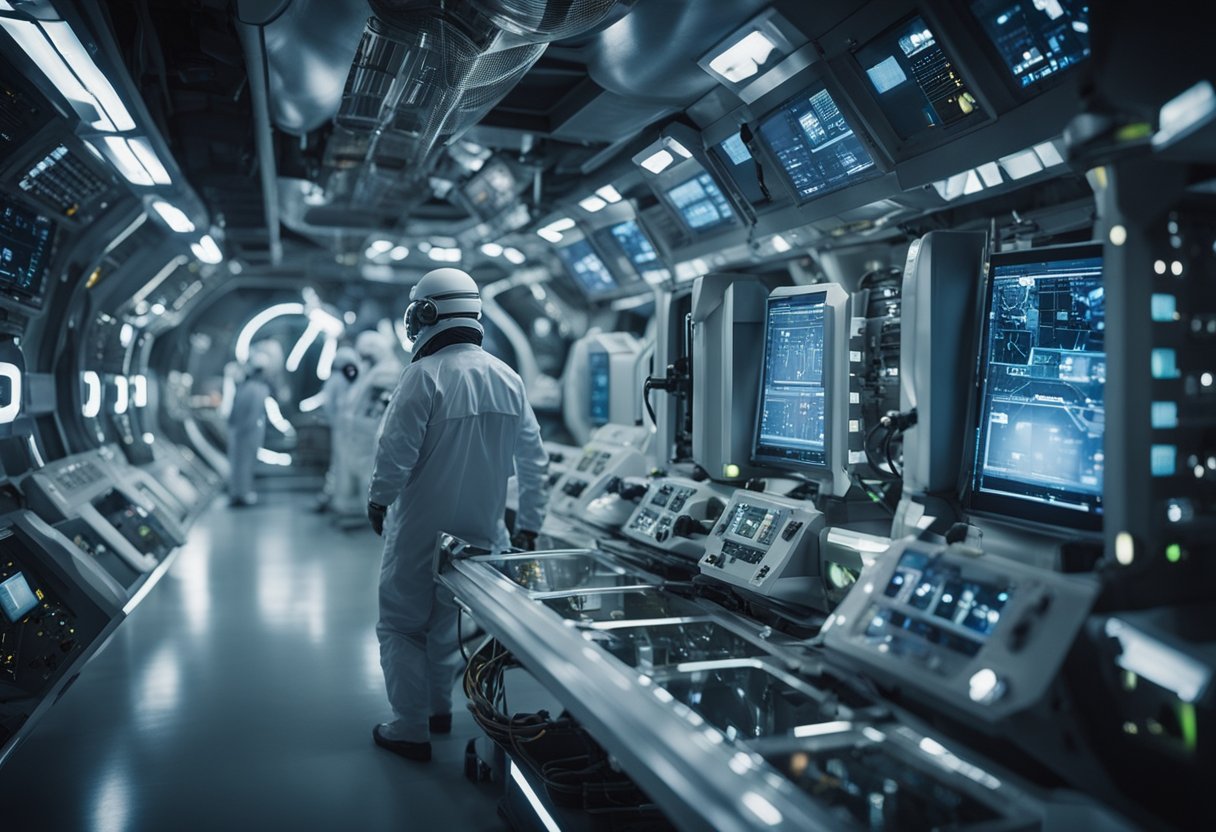
In our quest to establish space colonies, the fusion of technology and engineering forms the bedrock of robust Life Support Systems (LSS). The advancements and reliability of these systems are paramount for sustaining human life beyond Earth.
Science and technology are spearheading the development of closed Life Support Systems on space colonies. We observe state-of-the-art innovations that harness a symbiosis between plants and microbial processes, integral for producing and recycling vital resources. Such systems are meticulously designed to minimise dependency on Earth’s supply chains, as evidenced by the work published in Nature on the cornerstones of environmental control.
Engineering designs and modelling constitute the blueprint upon which life support infrastructures in space are built. We see rigorous application of models that include repair and maintenance simulations, ensuring the longevity of systems during long-duration missions. This proactive approach is encapsulated in the planning detailed on NASA’s attempts to fortify life support systems, as seen in their Life Support Systems Design and Development document.
As engineers, we constantly refine engineering design and modelling techniques to predict performance and optimise the functionality of LSS. Our models assess the efficacy of system components, right down to the micron level, and anticipate outcomes of potential system failures.
Collaborative engineering endeavours utilise cutting-edge technology to develop reliable systems that can withstand the rigours of space and lunar or Martian environments. The insights from platforms like SpaceVoyageVentures.com indicate a pressing need for durable life support systems, poised to cater not just to pioneering astronauts but to future space tourists as well.
Through precision-engineered components and smart integration of local space resources, we construct resilient architectures capable of supporting life far from Earth’s cradle. Our continuous refinement and expansion of life support science and technology symbolise our collective drive to reach new frontiers in human space exploration.
In space habitats, the environmental control systems are vital for maintaining conditions suitable for human life. These systems regulate air composition, pressure, and temperature, while continuously monitoring for safety and comfort.
We understand the crucial balance required in space habitats to maintain a stable climate. The Environmental Control and Life Support System (ECLSS) expertly manages this by providing oxygen, removing carbon dioxide, and regulating temperature and humidity. Sensors play a vital role, consistently feeding data to the environmental monitoring systems to ensure all parameters remain within habitable ranges.
Dealing with environmental factors such as waste and resource recycling is a complex challenge in the confined spaces of a habitat. Our cutting-edge technology includes systems like the Water Recovery System (WRS), which purifies and filters water, pivotal for extended missions and minimising resupply needs from Earth. We must also consider the potential impacts of climate change on Earth, as it may influence the technology and redundancy systems we develop for space settlements.
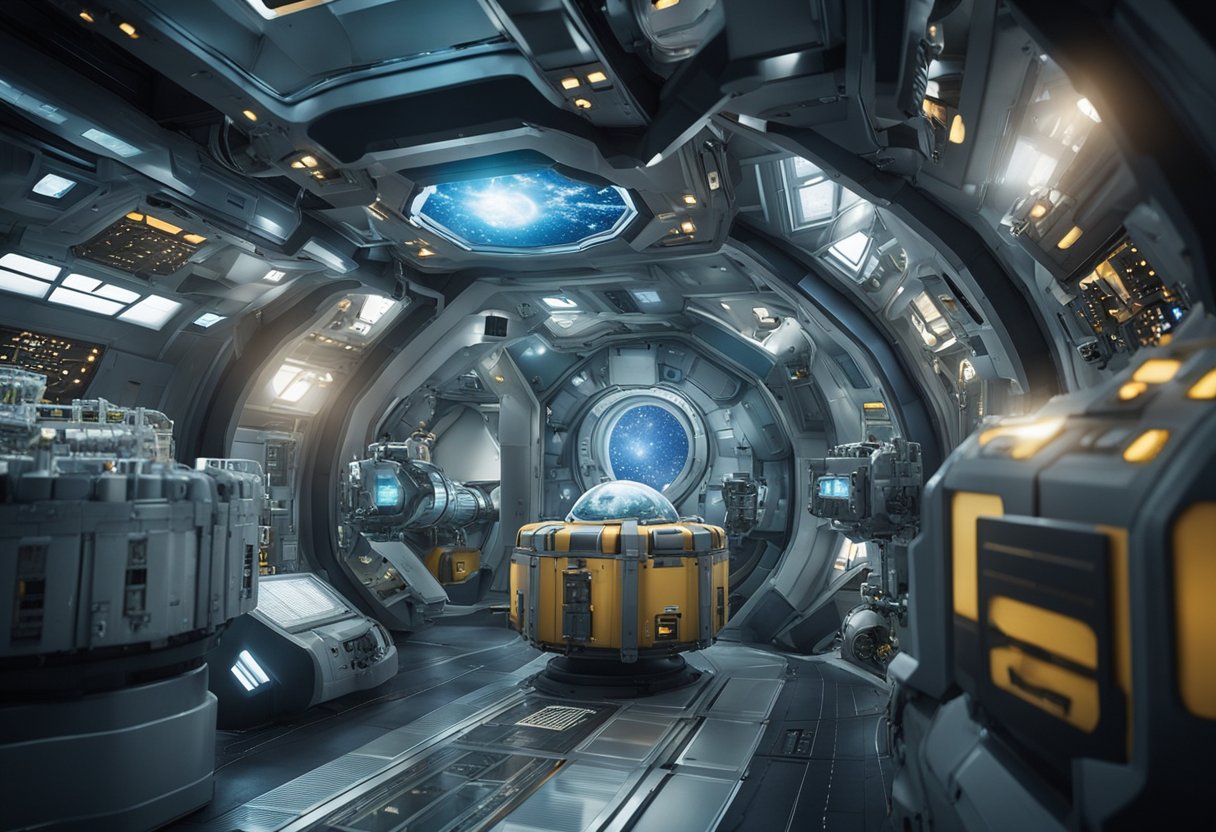
In establishing life support systems for space colonies, we must carefully evaluate cost efficiency and resource allocation, along with the inherent challenges presented by supply chain and logistics.
Achieving cost efficiency in space colonisation necessitates a balance between the initial investment and ongoing operational costs. We assess the cost per pound of material sent to space, striving to reduce this by maximising the efficiency of each life support system component. Technologies that recycle water and air play a crucial role, as they decrease the need for constant resupply. Investments in technologies like the Environmental Control and Life Support System (ECLSS) prove vital in closed-loop recycling, minimising waste and reducing the quantity of supplies needed from Earth.
We also focus on resource allocation, prioritising life-sustaining elements — oxygen, water, and food. By implementing systems like MELiSSA (Micro-Ecological Life Support System Alternative), which mimic Earth’s ecosystems to generate these essentials, we achieve a greater independence from terrestrial resources.
Managing supply chain and logistics for space colonies presents unique challenges. Every item sent from Earth must be meticulously planned due to the immense costs associated with space transport. We must ensure optimal storage and usage, intertwined closely with mission duration and the capacity for in-situ resource utilisation.
Moreover, unforeseeable variables such as launch delays or equipment failures can disrupt the supply schedule, necessitating robust contingency plans. Insight from experiments and missions, including the experiences of the Skylab station, are invaluable for us to anticipate and mitigate these challenges effectively. Notably, advancements in space manufacturing promise to ease these logistic hurdles by enabling the production of necessary items directly in space.
As we are on the cusp of expanded space travel, agencies such as SpaceVoyageVentures.com explore the future of space tourism, which will burgeon alongside traditional forms of cosmic exploration, potentially altering logistical dynamics as these ventures become more commonplace.
As we venture into deep space towards Mars and the Moon, life support systems (LSS) must be tailored to support human life for extended periods, ensuring a consistent supply of essential resources like air, water, and food.
For Mars and Moon colonies, we are designing life support systems that not only recycle air and water but also integrate local resources in a process called in-situ resource utilisation (ISRU). This adaptation is critical for missions where resupply from Earth is impractical. The systems must be robust to handle the harsh conditions and reduced gravity environments of these celestial bodies.
On the Moon, LSS must contend with lunar regolith, which can pose challenges for mechanical filtration systems. Mars presents its unique challenges, such as vast temperature shifts and dust storms, which require innovative solutions for maintaining habitat integrity and the function of LSS.
During long-duration spaceflights, like those to Mars, life support systems must operate with unparalleled reliability. The focus is on closed-loop systems, which are designed to minimise waste and maximise the reuse of water and oxygen. The success of these systems is vital for maintaining the health and safety of astronauts aboard manned spacecraft.
A critical aspect is water recovery, as highlighted by the Environmental Control and Life Support System (ECLSS) on the ISS, which recycles water with remarkable efficiency. For deep space missions, leveraging such technology will be a cornerstone in our overall life support strategy.
In preparing for these journeys, SpaceVoyageVentures.com plays a role in educating the public about the complexities and achievements in life support systems for deep space exploration, mapping out our journey into the final frontier.
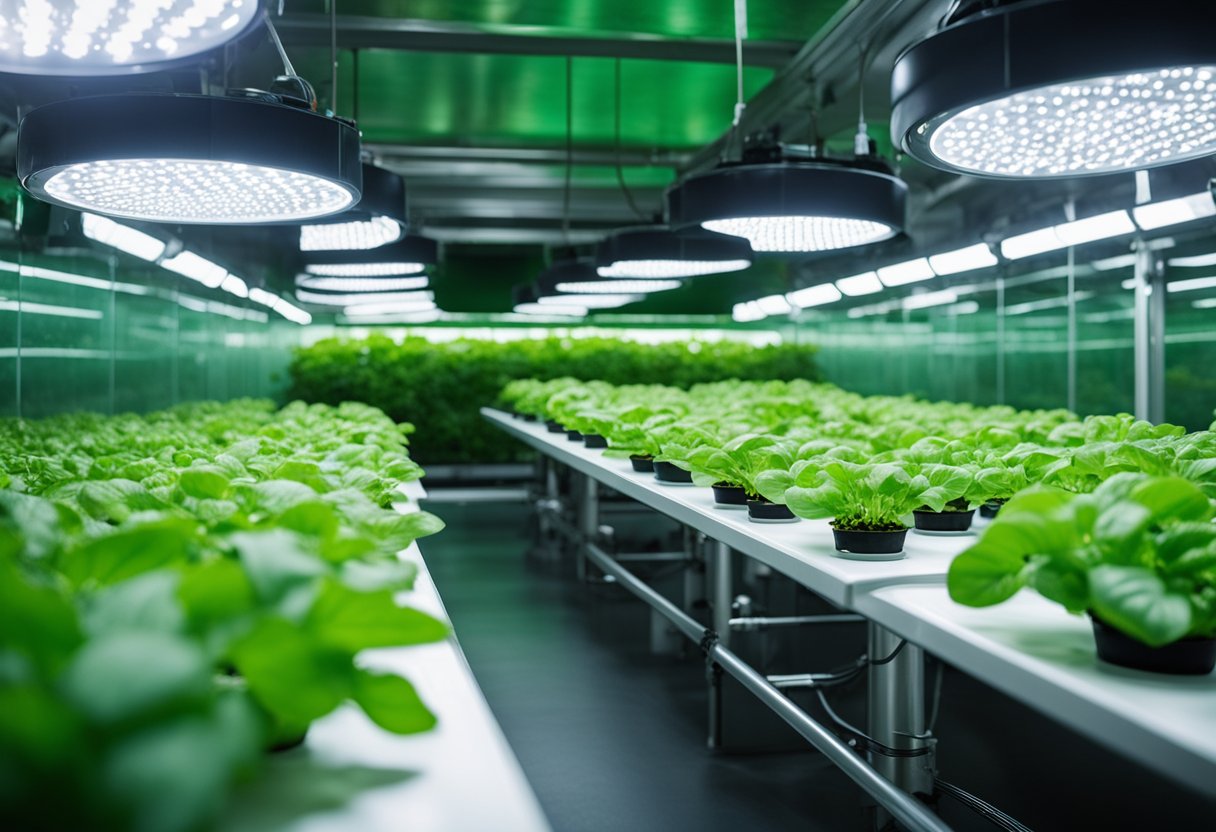
Establishing a reliable food supply is crucial for the success of long-term space missions and the sustainability of space colonies. We must develop effective methods to cultivate crops under the unique conditions of space and implement advanced agro-technologies to ensure a consistent food supply.
Growing food in the challenging environment of space requires innovative cultivation techniques that can overcome the lack of gravity. Crops in microgravity not only need to sustain growth but must do so efficiently to support the nutritional needs of astronauts. Orbital Technologies has partnered with Kennedy Space Center to create the Veggie plant growth system, which allows for the production of leafy greens like lettuce. This system is an evolution of earlier attempts, such as the Biomass Production System, representing a significant step forward in space farming.
By addressing these challenges, we can enhance crop production, providing fresh food that can greatly improve the physical and psychological health of space travellers.
The development and implementation of space-focused agro-technologies are vital for the long-term sustainability of food production. Space greenhouses and Bioregenerative Life Support Systems (BLSSs) are prominent examples of such technologies, designed to support life by integrating biological and physical-chemical processes. They represent a self-sufficient approach to generating food, oxygen, and clean water while recycling waste products. Additionally, research funded by entities like NASA and SpaceX is actively exploring these technologies, highlighting their potential benefits for future Mars colonies and beyond, with parallel advantages anticipated for Earth.
With agro-technologies tailored for space conditions, we move closer to the goal of creating a sustainable living environment for humans beyond Earth, not only for the occasional traveller but for entire colonies that may one day call space their permanent home.
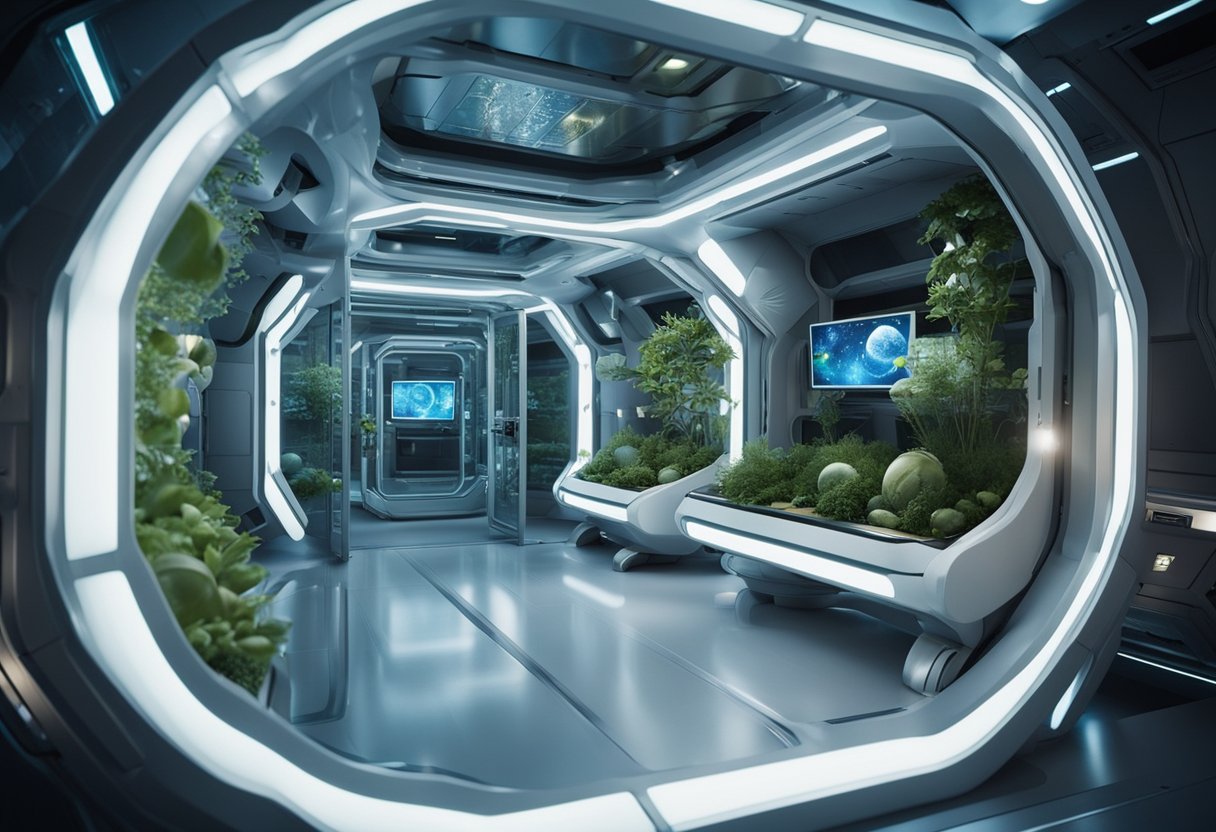
In establishing life support systems for space colonies, we must ensure that both the physical and mental health of astronauts are adequately maintained, alongside the necessity for a sustainable environment that can support human life long-term.
To sustain human life in space, we meticulously design nutrient delivery systems that ensure a balanced intake of vitamins, minerals, and calories. In space colonies, incorporating biotechnology we can regenerate resources. The Micro-Ecological Life Support System Alternative (MELiSSA), supported by the European Space Agency (ESA), exemplifies a system utilising interconnected bioreactors to mimic Earth’s natural nutrient cycles, providing continuous nutrient delivery and waste recycling capabilities. Systems similarly inspired by MELiSSA, focus on the circularity of resources, critical for minimising resupply from Earth and enhancing long-term sustainability.
Our physical health in a microgravity environment requires regular exercise to counteract muscle atrophy and bone density loss. We implement exercise regimens adapted for these conditions, using specialized equipment such as resistive and cardiovascular machines. On the other hand, mental health is as crucial, addressed through designing habitats with comfort in mind, ensuring private and communal spaces for tranquillity and interaction among inhabitants, a concept explored at SpaceVoyageVentures.com. In fostering both physical and mental well-being, we contribute significantly to the sustainability and success of space colonies.
In implementing these strategies aboard space colonies, we integrate sophisticated technology and a deep understanding of human needs to create a life support framework that promotes health, well-being, and environmental sustainability.
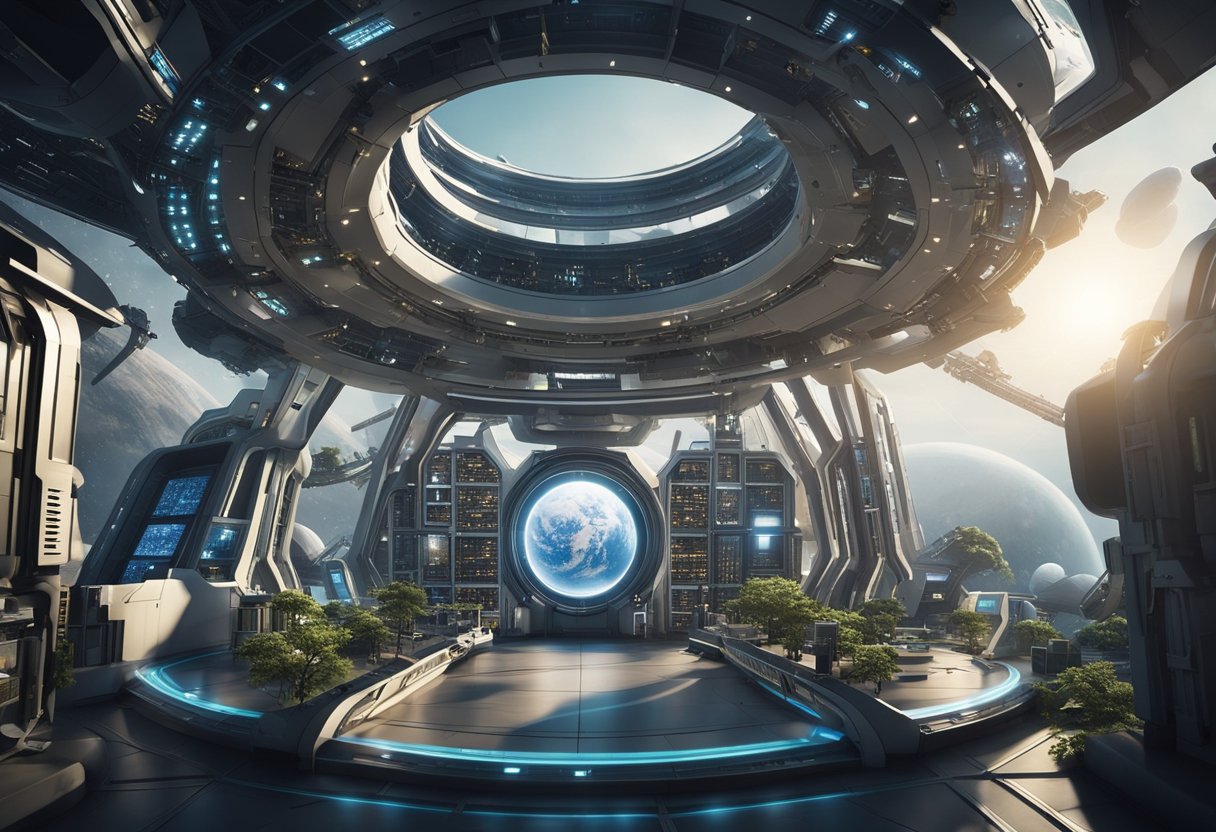
In preparing for human exploration beyond Earth, we must focus on designing habitats that address both the psychological and physiological needs of astronauts. The complexities of living organisms in the harsh environment of space require meticulous planning in habitat design to ensure not only survival but also the comfort and efficiency of the inhabitants.
When we discuss living and working conditions in space colonies, particularly on a lunar base, our primary consideration is the well-being of the inhabitants. Living organisms are not adapted to the vacuum of space, so our habitats must fully compensate for this with life support systems that provide a breathable atmosphere, suitable pressure, temperature control, and protection from space radiation.
Space colonies will be a blend of living and working spaces. The planning of these areas is critical to maintain a balance between operational efficiency and the mental health of the crew. Long-term human exploration missions will rely heavily on a habitat design that allows for both privacy and communal activities, which are essential for psychological well-being.
Our approach to habitat design for space colonies focuses on maximising efficiency and comfort. We incorporate advanced technology and human factors engineering to create environments that are more than just liveable—they enhance the experience of living and working in space.
Ergonomics, for example, is at the forefront of our design process, ensuring that every aspect of the habitat fits the needs of its residents. This includes adjustable workstations, tailored sleeping quarters, and communal areas designed for microgravity conditions. Moreover, the utilisation of modular design allows for the habitats to be adaptable, which is crucial as the needs within the colony may change over time.
Efficiency in a habitat’s design also encompasses the sustainable use of resources, minimising waste, and maximising the recycling of materials. These principles are vital in supporting a self-sufficient colony, where resupply missions are minimal, and the colony can thrive autonomously.
By focusing on these fundamental aspects of habitat design, we facilitate a future where living and working in space colonies is not just a possibility but a comfortable reality. As we venture further into space, the lessons learned and technologies developed here will underpin the success of interplanetary human settlements.
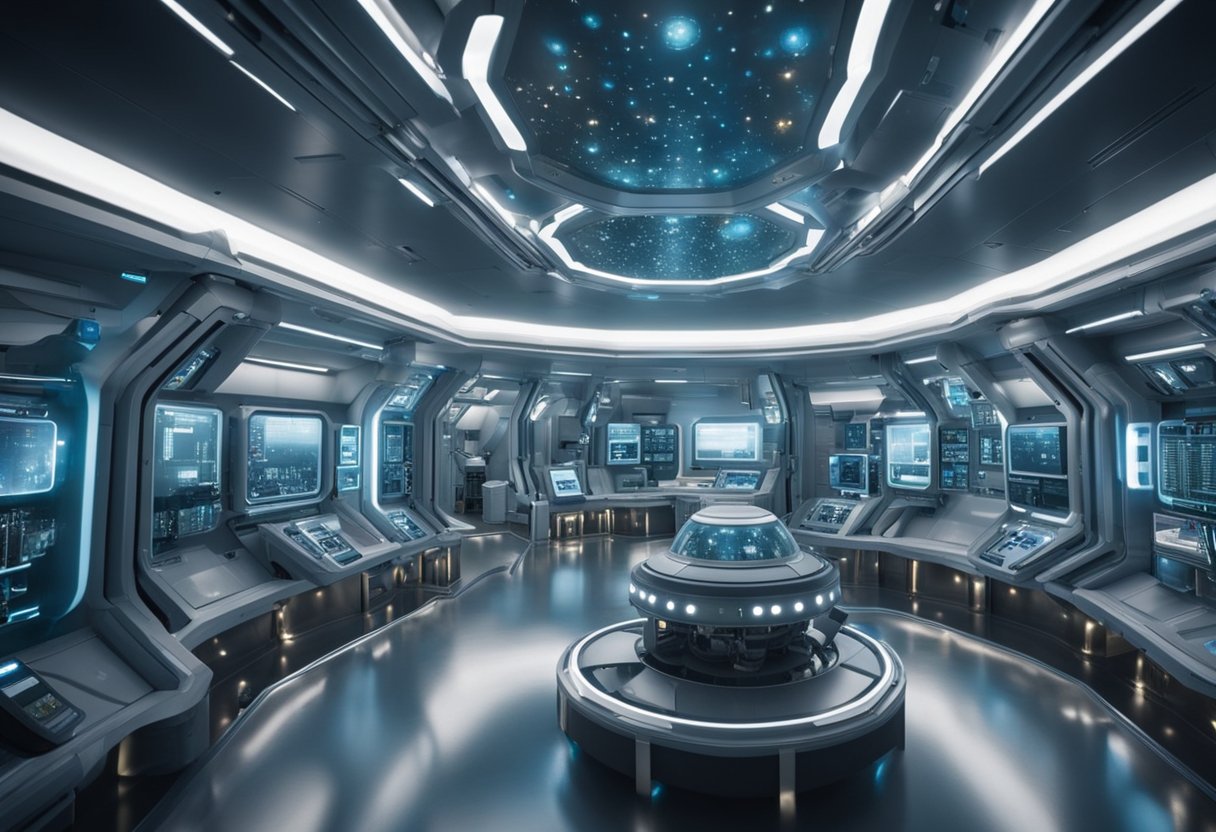
As we explore space, the repercussions on Earth are profound, ranging from advancements in Earth science to the development of new technologies that permeate our daily lives.
Space exploration significantly enhances our understanding of Earth’s climate and environmental systems. Satellite technology has been instrumental in tracking climate change, providing vital data on sea level rise, atmospheric gases, and the health of our ecosystems. For example, Earth-observing satellites continuously monitor and collect data that guide policymaking necessary for environmental protection.
Our push into space acts as a catalyst for technological progress with many societal benefits. Innovations developed for space missions can have unexpected applications on Earth. These include improvements in medical imaging, water purification, and even wireless communications. The technology transfer from space research to consumer products underscores the intertwined relationship between our celestial pursuits and life on Earth. Furthermore, the knowledge we gain about other planets enhances our understanding of our own, providing insights into the origins of our solar system.
In this section, we cover some of the key queries regarding life support systems in space habitats, addressing how these systems support life in the harsh environment of space.
The critical components of life support systems in space include atmosphere regeneration, water purification, waste processing, and food supply management. Technologies for these functions vary, but they typically incorporate advanced physicochemical processes and may also involve bioregenerative methods. Here’s a look at space station technology that teaches us about these systems.
Artificial gravity necessitates unique design considerations for life support systems, as it influences water and air flow, waste management, and the general behaviour of biological systems. Gravity must be simulated in a manner that ensures the proper function of these critical systems.
Life support systems on long-duration space missions utilise advanced water recycling processes, turning sweat, urine, and moisture from the air back into potable water. Solid waste can be processed and repurposed, and carbon dioxide is removed from the air and can be used to grow plants. This resourcefulness is key in making spaceflight more affordable.
The cost of implementing and maintaining life support systems encompasses initial design, deployment, repairs, and updates. As recycling and efficiency technologies improve, so too does the affordability of maintaining these critical systems in space colonies.
Advancements in life support technologies for future exploration include more efficient systems for recycling air and water, developing compact and reliable food production methods, and improving the overall closed-loop efficiency of life support systems. These innovations aspire to extend human presence further into space, as documented on Life Support and Habitation Systems.
Life support systems manage oxygen levels through a combination of processes including water electrolysis, which produces oxygen, and the removal of carbon dioxide through chemical scrubbers or other advanced technologies. Efficient balancing of these gases is crucial for maintaining a habitable environment in space.